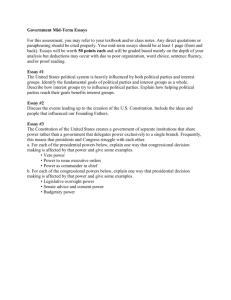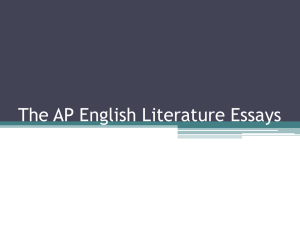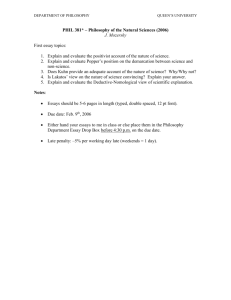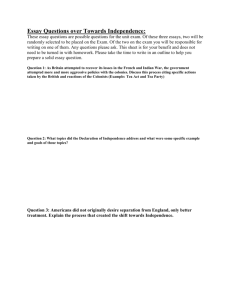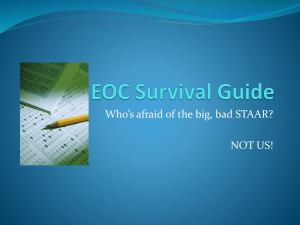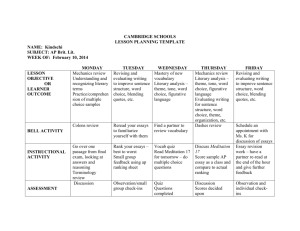Advanced Placement English Literature and
advertisement
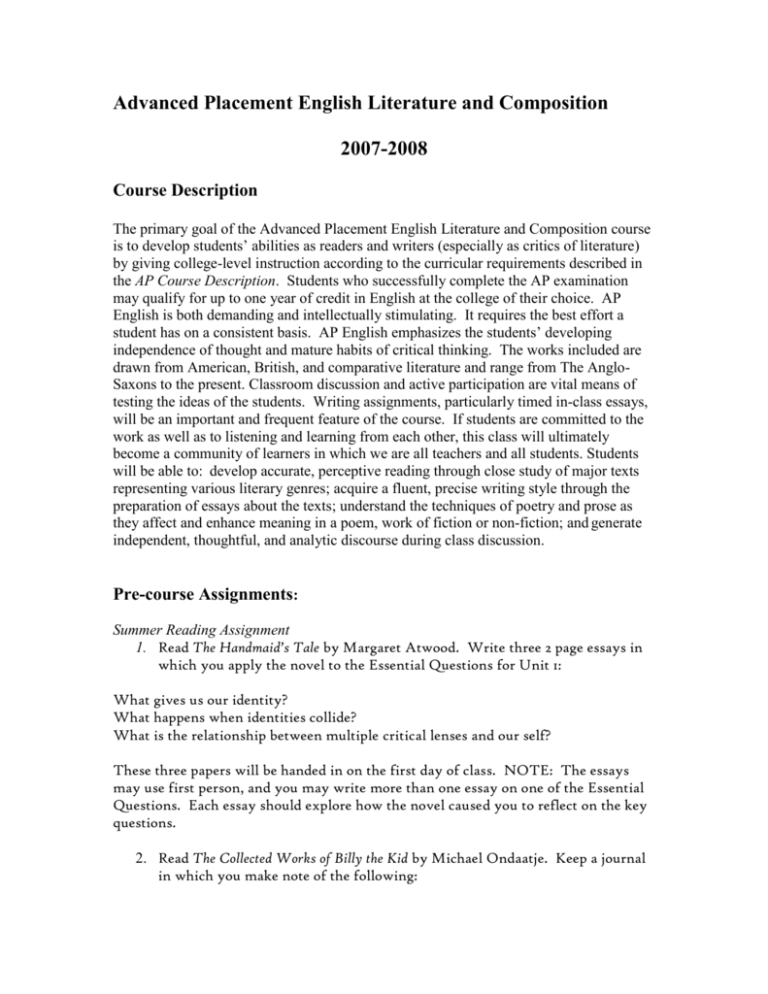
Advanced Placement English Literature and Composition 2007-2008 Course Description The primary goal of the Advanced Placement English Literature and Composition course is to develop students’ abilities as readers and writers (especially as critics of literature) by giving college-level instruction according to the curricular requirements described in the AP Course Description. Students who successfully complete the AP examination may qualify for up to one year of credit in English at the college of their choice. AP English is both demanding and intellectually stimulating. It requires the best effort a student has on a consistent basis. AP English emphasizes the students’ developing independence of thought and mature habits of critical thinking. The works included are drawn from American, British, and comparative literature and range from The AngloSaxons to the present. Classroom discussion and active participation are vital means of testing the ideas of the students. Writing assignments, particularly timed in-class essays, will be an important and frequent feature of the course. If students are committed to the work as well as to listening and learning from each other, this class will ultimately become a community of learners in which we are all teachers and all students. Students will be able to: develop accurate, perceptive reading through close study of major texts representing various literary genres; acquire a fluent, precise writing style through the preparation of essays about the texts; understand the techniques of poetry and prose as they affect and enhance meaning in a poem, work of fiction or non-fiction; and generate independent, thoughtful, and analytic discourse during class discussion. Pre-course Assignments: Summer Reading Assignment 1. Read The Handmaid’s Tale by Margaret Atwood. Write three 2 page essays in which you apply the novel to the Essential Questions for Unit 1: What gives us our identity? What happens when identities collide? What is the relationship between multiple critical lenses and our self? These three papers will be handed in on the first day of class. NOTE: The essays may use first person, and you may write more than one essay on one of the Essential Questions. Each essay should explore how the novel caused you to reflect on the key questions. 2. Read The Collected Works of Billy the Kid by Michael Ondaatje. Keep a journal in which you make note of the following: a) Repetitions: Locate exact repetitions – identical or nearly identical words or details – and note the number of times each repeats. b) Strands. A strand is a repetition of the same kind of detail or word, a grouping of the same or similar words or details. (For example, “polite, courteous, mannerly” or “accuse, defence, justice, witness” are strands. c) Binary Oppositions. Locate details or words that form or suggest binary oppositions. We call these binaries or organizing contrasts. Here are some examples: open/closed; naïve/self-conscious; grey/brown (note the opposition doesn’t have to be as stark as black/white or light/dark.) d) Choose what you think are the key repetitions, strands, and binaries – which may involve renaming them or labelling them – and rank them in some order of importance. e) Write one page in which you explain your choice of one repetition or one strand or one binary as especially significant to the overall meaning of the novel. The journal will be handed in on the first day of the second week of class. 3. You will be writing your own Collected Works in the AP Literature Class. You need to choose a topic that interests you, and do some research over the summer. You may choose a person (a writer, an athlete, a politician, a scientist, etc.) or an area of interest (a war, a branch of science, a machine, etc). This should be something that you have a keen interest in, as you will be researching and writing about the topic you choose for the whole year, in a variety of ways: poems, narratives, interviews, dialogues, and so forth. As you do your research this summer, you should take notes of important facts or insights in a research journal, and keep a bibliography of the sources you consulted. This may be one biography or work of non-fiction, or a number of relevant web-sites. I will be meeting with you early in the year to look at your notes and talk with you about the Collected Works assignment 4. Read All the Pretty Horses by Cormac McCarthy. Assignment: In an analytical essay (4-5 pages, 1.5 spaced, font 12), examine the work as a coming of age novel. Choose various events and conflicts throughout which illustrate the development of either Cole or Rawlins. You might want to review the Critical Questions for unit 1 to help you get started. Do not use first person in your examination. It is to be turned in the first week of school. Assignments and/or Assessments for each unit: Students are required to write one timed in-class essay a week as well as a formal essay each week (with at least two revisions). Both in-class and formal essays will be evaluated on each student’s ability in analysis, evaluation, and clear and precise written expression. Each student will actively participate in daily class discussions, keep on-going literary responses to each work read. The literary responses will be collected at the end of each week and checked for depth of analytical thought and understanding, vocabulary development, and stylistic examination. Often, students will be asked to imitate the form of a given author and comment on the function of the piece. In addition, students and be quizzed and tested on the material examined as is dictated by the works and unit. Course Units Unit One (First Quarter): The Nature of Good and Evil The essential questions for this unit are the following: What are good and evil? Is evil an intrinsic element of human nature? What is the result of the collision of moral systems? What is the difference between sin and evil? How does narrative point of view affect the presentation of good and evil? The major texts examined are Conrad’s, Heart of Darkness, Shakespeare’s, Macbeth, Ondaatje’s, The Collected Works of Billy the Kid, and O’brien’s, The Things They Carried. Stories include: Oconnor’s “A Good Man is Hard to Find,” Hawthorne’s “Young Goodman Brown,” Hemingway’s “The Short Happy Life of Francis Macomber,” Ellison’s “Battle Royal,” and Atwood’s “Rape Fantasies.” Essays include: Brodsky’s “A commencement Address,” and Orwell’s “Shooting an Elephant.” In addition, students are required to read an independent novel addressing the essential questions of the unit and write an essay at the end of the quarter. Content and Skills Taught: In this unit, each student will take a stance on their personal belief in the nature of good and evil and argue this position effectively both in writing and orally. These essays will be revised and peer edited for clarity and style. Students will also be expected to identify and examine imagery, diction, syntax, theme, symbol, tone, and mood in the various works throughout the unit as well as compare and contrast the various works and the authors’ varying approach to the themes. We will also examine the frame narrative. Unit Two (Second Quarter): The Nature of Truth. Narrative Traditions; Illusion and Reality The essential questions for this unit are the following: What is truth? Is Truth absolute or relative? What is the relationship between truth and language? How willing does an individual embrace truth? What if a “truth” impels one to violate an essential element of one’s self-concept? Do texts present truths or undermine them? The major texts examined are: Gardner’s Grendel, Miller’s Death of a Salesman, and Morrison’s Jazz. Stories include: Welty’s “A Worn Path,” Porter’s “Magic,” Silko’s “The Yellow Woman,” and Baxter’s “The Cliff.” Essays include: Plato’s “The Allegory of the Cave,” Orwell’s “Politics and the English Language,” and various selections from The Truth About the Truth. In addition, students are required to read an independent novel addressing the essential questions of the unit and write an essay at the end of the quarter. Content and Skills Taught: We will examine the social and historical values reflected in the works of this unit. One of the writing assignments will be a personal essay in which the student effectively argues his/her individual view of truth. In this essay, students will focus on structure and style, establishing a distinct voice. Another essay will address philosophy and post-modernism. Throughout the unit, students will write using a variety of genres. Unit Three (Third Quarter): The Nature of Identity: The Search for Identity- Perception in Personal and Literary Contexts The essential questions for this unit are the following: What gives one his/her identity? What happens when identities collide? What is the relationship between multiple critical lenses and one’s self? If language shapes identity, how does it do so? The major texts examined are the following: Kingston’s The Woman Warrior, Kafka’s The Metamorphosis, Shakespeare’s Othello, Joyce’s Portrait of the Artist as a Young Man, and Ibsen’s A Doll House. Stories include: Olsen’s “Here I Stand Ironing,” Boyle’s “The Astronomer’s Wife,” O’Conner’s “Good Country People,” Updike’s “A&P,” Lawrence’s “The Horse Dealer’s Daughter,” Gilman’s “The Yellow Wallpaper,” Walker’s “Everyday Use,” Kincaid’s “ Girl,” Tan’s “Rules of the Game,” and Chappell’s “Children of Strikers.” Essays include: Walker’s “In Search of Our Mother’s Gardens,” Atwood’s “Our First Stories,” and Hurston’s “How it Feels to be Colored Me.” In addition, students are required to read an independent novel addressing the essential questions of the unit and write an essay at the end of the quarter. Content and Skills Taught: Throughout this unit students will examine several texts through the critical lenses of various critical schools of literary criticism. They will analyze and discuss each in terms of truth, beauty, form and function. Students will demonstrate an effective use of rhetoric, including controlling tone, establishing voice, and achieving emphasis through diction, syntax, and structure. A careful examination and experimentation of a variety of sentence structures will be a major focus in essay writing. Unit Four (Fourth Quarter) Poetry/Writing Workshop/ Test Preparation This unit will focus on reading and analyzing poetry, writing AP style essays, as well as examining multiple choice style questions from practice AP exams. Content and Skills Taught: How to organize, structure, and prepare effective AP essays (poetry, open ended, and prose prompts) will be a major focus of this unit. Students will examine logical organization, using various techniques to enhance coherence, transition, repetition, and emphasis of argument. They will achieve a balance of generalization and specific, illustrative detail in their writing. Process of elimination techniques for multiple choice questions from practice AP exams will also be addressed. An emphasis will also be placed on recognizing and explaining the connection between form and function throughout the works examined in the unit. In the examination of poetry in this unit, students will be introduced to and expected to demonstrate proficiency using MOMENT, (an acronym for a series of prompts developed by Dr. Michael Hogan in An Analytical Approach to Poetry) which will allow them to work toward a fuller appreciation of a poem and write a more in-depth essay on the AP exam. It also provides a way of looking at poetry beyond the traditional academic analysis of theme and structure, towards a more holistic and eventually intuitive understanding. The elements of the acronym are not to be examined with their correlatives in a linear manner but rather in a recurrent and speculative one. Each element of MOMENT stands for the following: Moment: The place in the poem where the reader is struck by the force of an image. Opposition: The texture of the poem when it shows, for example, contrast of light and dark, cacophony and euphony, or other opposing forces or elements. Movement: The change of direction in a poem which add to its depth and complexity. Evocation: What is the mood or emotion evoked by the images, diction, or music in the poem and to what end? Notation: How might the musical structure of the poem be transcribed by the reader: short versus long lines, number of feet, end stops, susurrus, iambics, etc. and what relevance does this music have to other elements of the analysis? Tension: All of the above are elements which are crafted by the poet to create tension in the poem. Tension has many purposes, from the simple strategy of keeping the reader interested to moving the reader from a shared experience to a sudden leap of understanding. Or it could take a familiar image and, by presenting it in an unfamiliar way, lead to new insight. After the AP Exam There will be an intense focus on the completion of student’s “Collected Works.” The “Collected Works” is an ongoing work throughout the academic year. The guidelines are as follows: MULTI-GENRE WRITING ASSIGNMENT (Collected Works) The Collected Works of Billy the Kid is an example of a multi-genre work. Michael Ondaatje uses narratives, poems, songs, interviews, comic books, photographs, and other genres to create a portrait of his subject. Now you are going to do the same thing. These works are NOT biographies or research papers. Any Collected Works that is simply biography will not be accepted. Nor are they essays. You are not trying to explicitly articulate a position about your topic. You are, instead, using a variety of genres to create small “moments” that, taken together, may lead to a reader creating his or her own interpretation of the subject, as you did when you created your pictures of Billy the Kid. The Final Product will have: A minimum of 10 written pieces. Of course, you should include images in addition to the written requirements. Of those ten pieces, at least four must be poems At least two must be narratives The rest of the pieces are up to you to decide. Anything that you use in your collected works that comes from another source must be in italics. (For instance, if you are writing a poem about Emily Dickinson and you use a line from one of her poems in your poem, put that line in italics.) A cover with some sort of image or design, not just text. A Works Cited page using proper MLA format. (See me if you are not sure of what MLA format is. Include all sources you consulted, even if you did not quote from it in your Collected Works.) FORM/FUNCTION PIECES. For each piece, you must write a Form/Function description. In this you identify the Purpose that you wanted the piece to fulfill, and talk about the literary techniques that you used to fulfill that purpose. You must explain what you were attempting in each piece, and discuss the decisions that you made as an author as to how best succeed in that attempt. Example. I felt that I needed to show that Mark Twain was not the gentle humorist that most people think of when they speak of him. So much of his life was bitter, and he was a very angry man towards the end of his life. I wanted this piece to show a bit of that anger. I tried to do this in several ways. First, the diction. Words such as “stark,” “bleak”, “black”, “rage” (which I repeated three times, including as the rhyming word in the final couplet), “void”, “animal” “bile” and “darkness” all try to carry that meaning. I also used the meter of the poem to communicate his growing disillusion. The first two stanzas are almost perfect iambic pentameter, with no caesuras and with frequent enjambment to make the poem flow in a measured, ordered way. With the third and fourth stanza, I start to use spondees and caesuras, often indicated by exclamation points, to show the increasing stridency of his thoughts and his loss of faith in an ordered universe. For example, in the line “Stark words rage! Blow, bile, bellow in the dark beyond the last laugh” I started with three stressed syllables followed by a caesura. Three more stressed syllables follow the exclamation mark, and the rhythm never resolves into regular iambic, using instead an anapest (in the dark), two iambs (beyond the last), and a final stressed syllable, by itself (laugh) to emphasize how laughter no longer fits into the rhythm of his life. Throughout the collected works I have used images of tobacco, and is this poem I show him “crushing” the cigar butt and “gobbing the dark juices from his lungs.” In earlier pieces I used tobacco as an instrument of humor, but now that image has also become darker. The cigar ashes on his white suit connects this image to the images of his clothes that I have used throughout the work. Be specific in these explanations. Don’t just tell me what the purpose of the piece was or what the piece means. Tell me, in detail, why you wrote it the way you did, and demonstrate how your choices support the purpose of that piece. For each piece in your collected works, staple the Form/Function explanation to all rough drafts of that piece, and hand those in separately. Evaluation Title Page Works Cited Form/Function pieces Polished Collected Works (On time and meets the minimum requirements) 10 10 60 20 Most Fridays will be devoted to work on this assignment, as long as you use the time given productively. Use the time to write, revise, edit, and have a conference with me. Four pieces (polished with Form/Function pieces) must be completed before the end of the first semester. The remaining six pieces will be completed by the end of the year. Course Evaluation Quizzes Polished Writing Portfolio (Collected Works) Independent Reading and Responses 30% 40% 15% 15% Textbook DiYanni, Robert. Literature: Reading Fiction, Poetry, and Drama. Boston: McGraw Hill, 2007. Web Sites AP Central- apcentral.collegeboard.com




